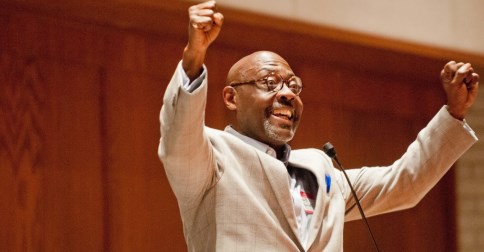One of the most talked-about books on the internet this week is Rod Dreher’s The Benedict Option:A Strategy for Christians in a Post-Christian Nation, which arrived in bookstores on Tuesday.
On a practical level, there is much common ground between the sort of deep communities that John and I advocate for in Slow Church, and those that Dreher envisions in The Benedict Option. Furthermore, Dreher offers a similar account of the fragmentation that Western culture has undergone over the last 500 years.
The substantial difference, however, is that Dreher’s account seems to be predicated upon conservative ideology, and the BenOp communities that he prescribes would consist of like-minded conservative Christians (or traditional / orthodox Christians, other qualifiers that Dreher uses synonymously). In contrast, the communities in which Slow Church unfolds are our local church congregations, in all the messiness of their diversity. Although Dreher has emphasized that the Benedict Option is not a strategy of withdrawal from society, the conviction that Christians are being forced to the margins of society (and will continue to be marginalized further in the coming years) is prominent in Dreher’s work. While I definitely agree that Christendom is dead (or on life-support at best), in that Christianity is increasingly not part of the fabric of American culture in the ways that it has been for previous generations, I don’t see major forces at work to resist and actively marginalize Christianity, as Dreher does.
I have been following Dreher’s reflections on the Benedict Option since the outset, and have written a couple of pieces on our old Slow Church blog on Patheos, contrasting it with Slow Church [ HERE and HERE ]. I also reviewed The Benedict Option earlier this week for The Englewood Review of Books. Here are a couple of snippets, though I would encourage you to read the review in its entirety…
I agree with Dreher that to turn the tide of fragmentation, we need communities whose common life runs deeper than a single, weekly meeting, and where we are relearning what it means to belong to a people and a place. “[The] church can’t just be the place you on Sundays,” Dreher writes, “it must become the center of your life.” These communities will require us to work through questions of family life, vocation, education, technology, to each of which Dreher devotes a chapter in this book. These questions are questions that all real communities must wrestle with, and indeed are ones that many communities that are merely religious in nature are tempted to skirt.
But despite moving toward similar ends, I believe that Slow Church works from a different narrative and takes a different course:
Dreher rarely speaks in unqualified terms of the Christian tradition, but rather prefers to add qualifiers: “conservative Christianity,” “orthodox Christianity” (small o), or “traditional Christianity.” This incessant qualification serves to propagate further the sorts of fragmentation that Dreher recognizes as indicative of our age. So my question for Dreher is: What is the primary community/tradition with which you identify yourself? Conservativism? Conservative Christianity? Or Christianity (period). If one of the former two of these options, I can recognize many insightful ideas in this book, but ultimately you and I are working from different traditions and thus incompatible frameworks for interpreting the world. Additionally, either of these first two traditions (as would their mirror images in the ideology of Left) because they are defined in opposition to the Other, only add further layers of fragmentation to those that you rightly attribute to the forces of modernity. However, if the primary tradition with which you identify is Christianity, whose primary, scriptural narrative is not defined over and against an Other, but rather is constituted by a God who not only created all humanity and who is sovereign over human history, but who also is engaged in the slow and patient work of reconciling all humanity (see, for instance, Col. 1), then we share this tradition in common.
And lastly, the note on which I conclude:
I wish this book could be read and discussed broadly, but Dreher’s occasional adopting of the shrill tones of a culture warrior (which in reality is a fairly small portion of the book, but recurs spottily throughout almost all the book’s chapters), will impede the reception of his rich, practical wisdom in this volume with many readers (not only those on the Left, but also many of those who do not neatly fit the categories of Right or Left, but simply identify primarily as Christians).
As I was working on my review, I was reminded of the tension that Walter Brueggemann identifies in the Ancient Israelite people, between purity and neighborliness. It seems to me that Dreher is more inclined toward purity, whereas Slow Church tends to err on the side of neighborliness. As I was refreshing my memory on Brueggemann’s work on purity/neighborliness, I stumbled upon this piece he wrote 20 years ago, that could be read today as a striking response — that is both appreciative and challenging — to the Benedict Option:
[We] can learn from the Old Testament to proclaim the God who creates new social possibilities beyond the shrunken horizons of defeat and submissive docility. The exiles in Babylon faced an empire that seemed to circumscribe and dictate everything, just as the military-industrial complex seems to circumscribe our lives. Ancient Israel came within a whisker of being able to imagine its future only in the terms permitted and sanctioned by Babylon. Into this scene stepped the prophet Isaiah, the most vigorous, daring and imaginative of all the voices of faith during the exile.In the midst of the suffering and despair of his people, Isaiah offered a radical new possibility. He dared to say defiantly, in the face of imperial power, “Your God reigns.” The God who is here proclaimed anew announces comfort and asserts that the time of suffering is ending. Isaiah invites his community to return home: “Depart, depart.. . go out from the midst of it” (52:11) You shall go out in joy, /you shall be led back in peace” (55:12).
The return from exile may indeed be geographical. But first the movement is emotional, liturgical and imaginative; it requires forming a vision of the future free of the fearful dreams of entrenched power. It demands that we imaginatively free ourselves from the powers that have kept us in thrall, perhaps to a complacent orthodoxy, perhaps to excessive self-protection and self-assurance, perhaps to the fraudulent comforts of imperial finance and weaponry. One can almost sense in Isaiah’s daring poetry the dancing lightness of a small child, countering the weary soberness of jaded adults who have held the world too long in one position. The return from exile begins with an emotional act of civil disobedience.
and
In our time of dislocation the church can offer ways of speaking and acting that the dominant society regards as subversive, but without which we cannot for long stay human. It can express sadness, rage and loss as an alternative to the denial that inevitably breeds brutality. It can be a voice of holiness that counters the trivial commodity-centered world by the practice of disciplines that make communion possible. It can be a voice of imaginative, neighborly transformation, focused on those in need. And it can express new social possibilities, rooted in the truth of God’s good news. Before us is the choice between succumbing to a fearful self-preoccupation that shrivels the spirit or heeding God’s call to re-enter the pain of the world and the possibility of renewal and salvation.
I am convinced that Dreher is asking many vital questions, but my sense is that little attention will be paid to his work outside the Conservative bubble.









![Book Giveaway – Reading For the Common Good [3 copies]](http://slowchurch.com/wp-content/uploads/2017/05/RFTCG-Cover-Banner.jpg)

One Response
Denise Frame Harlan
Thank you, Chris. I also read Byron’s review from Hearts & Minds, and Brooks’ review. I appreciate the quote about “the tension that Walter Brueggemann identifies in the Ancient Israelite people, between purity and neighborliness. It seems to me that Dreher is more inclined toward purity, whereas Slow Church tends to err on the side of neighborliness.” Always good to read your analysis.